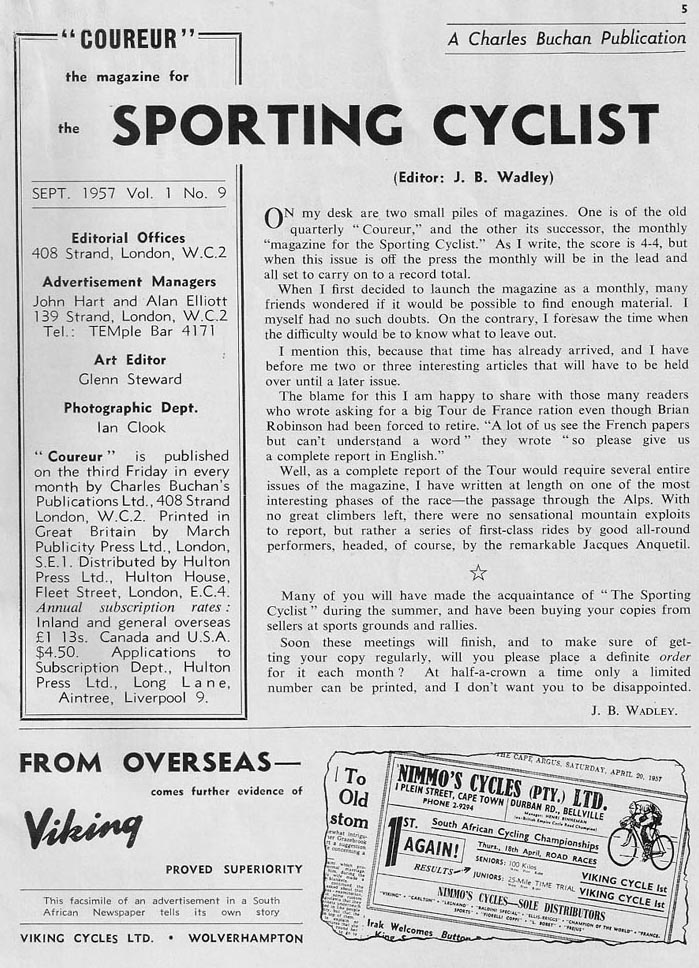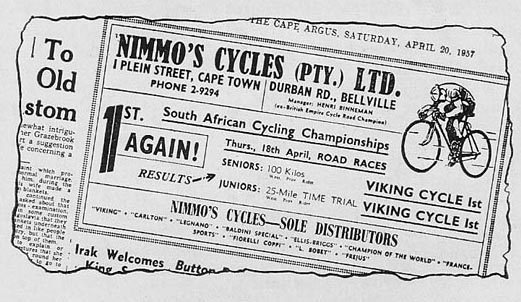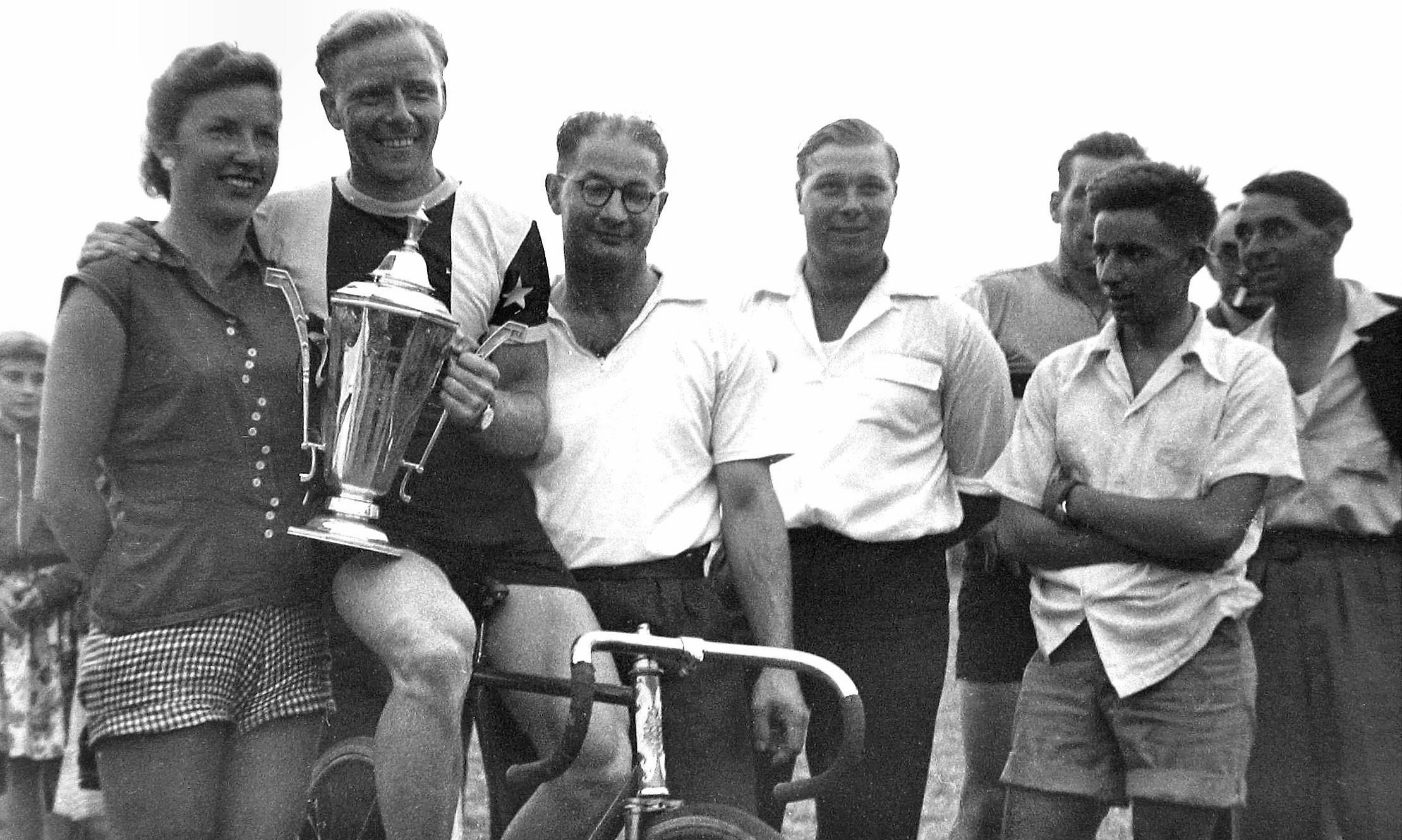Viking Cycles Ltd - cycling in South Africa
Posted: Sunday 23rd August 2020
A small item kindly forwarded to me by ‘Classic Lightweights’ editor Peter Underwood presents an intriguing puzzle.
What Peter sent was a copy of a page from a long–deceased publication (the incomparable monthly, “COUREUR”: the magazine for the SPORTING CYCLIST) carrying an advertisement for a discontinued brand of British lightweight (Viking) and incorporating a newspaper advertisement for a now defunct South African cycle retailer (Nimmo’s Cycles). I was prompted to inquire further into this curious alliance.
From the late 1950s onwards, Sporting Cyclist was the progressive voice of competitive cycling in the English–speaking world. Editor J.B. ‘Jock’ Wadley and his cycling journalists (whose ranks included triple Tour de France winner Louison Bobet’s brother, Jean) moved seamlessly between the British Isles with its fractious cycling tribes (the NCUs, RTTCs and BLRCs) and the then arcane world of Continental cycling: early season training with French ‘cowboys’ on the Côte d’Azur, Ray Booty time trialling in England, Dave Keeler End–to–Ending, Coppi on the Isle of Man, the Milk Race, the Ghent six–day. All appeared in black and white images (for which the ‘Peugeot’ chequered flag pro team jerseys made ideal subjects) on its pages, accompanied by articles written by cycling cognoscenti. The specific issue of Sporting Cyclist that carried the Viking advertisement in question was one of the earliest – September 1957, Volume 1, Number 9. It appeared on the editorial page written by Wadley himself who urged readers to subscribe ‘At half–a–crown a time’.
That Viking chose to advertise in Sporting Cyclist at all is surprising as the magazine’s main readership consisted of British club cyclists who preferred machines crafted by idiosyncratic local master builders who painstakingly tailored bespoke frames for a demanding clientele. Viking, on the other hand, was a medium sized off–the–peg lightweight bicycle producer based in Wolverhampton that sought publicity through sponsoring small home–based British independent and professional riders and teams. As Lightweight News (No. 12, Nov./ Dec. 2007: 2–3) observed:
Sporting Cyclist…Being a publication with much smaller circulation (than Cycling), …(had) advertising rates (which) were obviously much lower and as a result attracted the smaller builders of the day. These were the type of businesses which the club cyclists would patronise with a great sense of loyalty…One edition of Sporting Cyclist in 1958 had adverts for Rory O’Brien, Witcomb, Allins of Croydon, Carlton, Condor, Lipscombe, Gillott, Mercian, Holmes of Welling, Southern Cycles, Mal Rees, Carpenter, Meridian…
By advertising in Sporting Cyclist, Viking was clearly seeking to increase the street cred of its machines amongst cycling aficionados worldwide. The Nimmo’s Cycles advert that the Viking one incorporated fitted this bill perfectly in that it pointed to the racing successes of Viking machines on the global stage. This international emphasis was something which Viking had consistently pursued through, for instance, its association with Ian Steel (winner of the Warsaw–Berlin–Prague ‘Peace Race’ in 1952) even to the point of producing an ‘Ian Steel’ model. Furthermore, Viking seat tube transfers incorporated references to its successes in exotic events like the Tour of Mexico.


Nimmo’s Cycles – the third piece in this curious cycling jigsaw – was then the leading lightweight retailer in Cape Town, South Africa. Nimmo’s had two branches: one in central Cape Town, the other in the suburb of Bellville. Bellville was at that time a white working class area located on the Cape Flats away from the city’s scenic parts and a hotbed of competitive cycling in the Western Cape region. The Bellville branch was located on Durban Road which is a main arterial route through the suburb and this is why Peter originally sent the item to me. I live in the South African east coast city of Durban, but Durban is 1 800 kilometres from Cape Town. However, what Durban (the city) and the Bellville boulevard have in common is that both are named after Sir Benjamin D’urban, a patrician British governor of the Cape Colony in the early 1800s. (He subsequently transferred to Canada where the local citizenry declined to name anything after him). But I digress.
The Nimmo’s advert incorporated into the Viking one originally appeared in The Cape Argus, an English–language Cape Town daily newspaper on Saturday April 20, 1957. It proudly proclaimed that two days previously on Thursday 18th April at the South African Cycling Championships both the senior 100 Km. road race and the junior 25 mile time trial had been won by Western Province riders on Viking machines. Nimmo’s was the local agent for Vikings and, by implication, also the suppliers of the winning machines. In those days of strict amateurism this was sailing very close to the wind despite the riders’ names having been omitted from the advert. However, cross–referencing with contemporary official records reveals that the winner of the senior 100 Km. event was a certain W. van Wyk while the junior time trial had resulted in the timekeepers declaring a dead heat between D. van der Merwe and R. Peacock.
But the Nimmo’s advert contained much else besides. For instance, it states that the manager of the Bellville shop was ‘Henri Binneman (ex–British Empire Cycle Road Champion)’. Binneman’s triumph had taken place some twenty years earlier and is recorded in Jowett’s 1982 book, Centenary: 100 years of organised South African cycle racing (pages 57–9) as follows:
Hendrik Binneman won the 100 Kilometres Road Race at the British Empire Games in 1938 in Sydney, Australia…the race in Sydney was the first of a new technique of massed starts. South Africa had two starters, Binneman and Sid Rose (a track sprinter). They were opposed by teams from Australia, New Zealand and England. About 10 Kilometres from the start Rose was forced to drop out with cycle trouble and Binneman was left to race alone against all the competing teams. He won because he made the race to suit himself, and blocked any Team tactics he encountered. No praise could be too lavish for Binneman. He was great!
The competitors had to travel around a park fifteen times with sharp bends and steep gradients. Time and again the teams tried to shake Binneman off – but he was not to be denied. Binneman took the steep grades well and led the field at the 7th, 8th, 9th, 10th, 11th and 13th laps and had almost ridden the other competitors to a standstill. In fact only four riders were left in at the finish and in a mighty spurt, after 100 kilometres, the Springbok Binneman won by half a wheel – a glorious ride by a brilliant South African.
Binneman returned home to a hero’s welcome and was to remain an influential figure in both Cape and national cycling circles in the period after World War II.
But the Nimmo’s advert also discloses further details of the machines ridden by South African cyclists of that era, specifying that it was stockists of not only Vikings but also of the Carlton, Legnano, Baldini Special, Ellis–Briggs, Champion of the World, France–Sports, Fiorelli Coppi, L. Bobet and Frejus marques. These amounted to an international selection of machines ridden by the cycling icons of that era.
My thanks are thus due to Peter for drawing my attention to a seemingly–inconsequential advertisement tucked away in an old cycling magazine which proved to be a reminder of long–forgotten links in a cycling chain stretching back in time.
Posted: Sunday 23rd August 2020
Upcoming Events
Whether you are looking for a gentle social meet up, or a 100-mile ride browse the community’s upcoming events and plan your next weekend outing.
